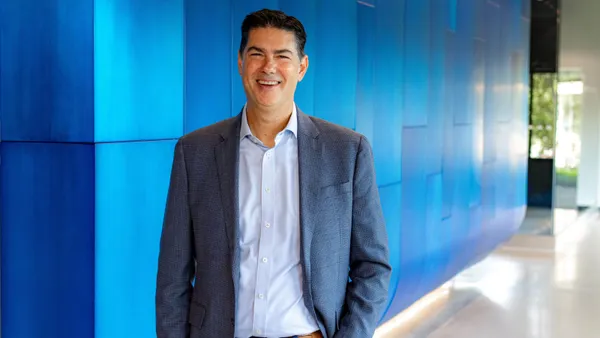Dive Brief:
- Inflation inched up last month on price gains in shelter, medical care, vehicle insurance and other services, underscoring that the Federal Reserve may need to hold the benchmark interest rate at a 22-year high longer than previously expected.
- The consumer price index rose 0.3% in December compared with 0.1% the prior month, and increased 3.4% on an annual basis from 3.1% in November. A 0.5% gain in shelter costs fueled more than half of the increase in inflation, the Bureau of Labor Statistics said.
- “There is still quite a bit of work to do in bringing down services inflation,” Fitch Ratings Chief Economist Brian Coulton said in a statement, adding that the data complicate efforts by Federal Reserve policymakers to hit their 2% inflation target. “This will give the Fed grounds for caution, and they are unlikely to cut rates as quickly as the markets currently expect.”
Dive Insight:
Fed policymakers, while suggesting that they have finished raising borrowing costs, have kept open the option of additional interest rate hikes. They have said a sustained decline in price pressures must precede any easing in policy.
“March is probably too early in my estimate for a rate decline because I think we need to see some more evidence” of slowing inflation, Cleveland Fed President Lorreta Mester said Thursday.
“I think the December CPI report just shows there’s more work to do, and that work is going to take restrictive monetary policy,” Mester said in an interview with Bloomberg TV.
Mester’s comments aligned with a speech by New York Fed President John Williams on Wednesday.
Cooling inflation during the past 18 months “is clearly a positive development, but it is important to stress that we still have a ways to go to get inflation back to the FOMC’s [Federal Open Market Committee’s] longer-run goal of 2%,” Williams said.
“I expect that we will need to maintain a restrictive stance of policy for some time to fully achieve our goals, and it will only be appropriate to dial back the degree of policy restraint when we are confident that inflation is moving toward 2% on a sustained basis,” Williams said in a speech.
Traders in interest rate futures brushed off the December inflation data, along with the message from policymakers.
On Thursday they increased the odds that the Fed on March 20 will trim the main interest rate by a quarter percentage point to 72% from 65% on Wednesday. The central bank currently keeps the federal funds rate at a range between 5.25% and 5.5%.
“It seems to me markets are a bit ahead of themselves on how much cutting the Fed should do, or likely will do, over the next few months,” former Treasury Secretary Lawrence Summers said Thursday, noting “a bit more medium-term inflation risk than markets see.”
U.S. consumers see limited risk that price pressures will surge again. They expect inflation to slow to 3% a year from now and to 2.5% in five years, the New York Fed said in a report Monday.
The central bank, noting progress in its most aggressive fight against inflation in four decades, said it will likely trim the federal funds rate by the end of 2024 to 4.6%, according to a median projection by Fed officials released on Dec. 13.
Traders in interest rate futures believe the Fed will cut borrowing costs much more aggressively. On Thursday they saw an 81% probability that the Fed by the end of 2024 will reduce the main rate to 4% or lower.
“I think it’s highly unlikely that the Fed begins aggressive rate cuts early this year,” Glenn Hubbard, a Columbia Business School professor, said in conversation with Summers during a webinar sponsored by the Economic Club of New York.
Core CPI — excluding volatile food and energy costs — increased 0.3% last month, unchanged from November. On an annual basis, core CPI rose 3.9%, or 0.1 percentage point less than in November.
After declining for six consecutive months, the price of core goods, which includes commodities excluding food and energy, were little changed in December.
















